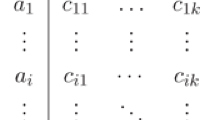Abstract
This article analyzes the conditions under which any change in a multiplicative background risk induces a more cautious behavior. We give necessary and sufficient conditions under which any change in the multiplicative background risk with respect to the Nth-degree stochastic dominance raises local risk aversion. Surprisingly, decreasing relative risk aversion of any order up to N in the sense of Pratt (Econometrica 32:122–136, 1964) coupled with decreasing relative risk aversion in the sense of Ross (Econometrica 49:631–638, 1981) are sufficient to guarantee an increase in local risk aversion after any deterioration of the multiplicative background risk thanks to the Nth-degree stochastic dominance. We link our results concerning second-order stochastic dominance with the concept of multiplicative risk vulnerability.
Similar content being viewed by others
References
Eeckhoudt L., Etner L., Schroyen F. (2009) The values of relative risk aversion and prudence: A context-free interpretation. Mathematical Social Science 58: 1–7
Eeckhoudt L., Gollier C., Schlesinger H. (1996) Changes in background risk and risk taking behavior. Econometrica 64(3): 683–689
Eeckhoudt L., Schlesinger H. (2006) Putting risk in its proper place. American Economic Review 96: 280–289
Eichner T., Wagener T. (2004) Relative risk aversion, relative prudence and compartatics under uncertainty: The case of (μ −σ)-preferences. Bulletin of Economic Research 56(2): 159–170
Franke G., Schlesinger H., Stapleton R. C. (2006) Multiplicative background risk. Management Science 52(1): 146–153
Gollier C., Pratt J. (1996) Risk Vulnerability and the tempering effect of background risk. Econometrica 64(5): 1109–1123
Keenan D., Rudow D., Snow A. (2008) Risk preferences and changes in background risk. Journal of Risk and Uncertainty 36: 139–152
Kihlstrom R., Romer D., Williams S. (1981) Risk aversion with random initial wealth. Econometrica 49(4): 911–920
Kimball M. (1993) Standard risk aversion. Econometrica 61: 589–611
Pratt J. (1964) Risk aversion in the small and in the large. Econometrica 32: 122–136
Pratt J. (1988) Aversion to one risk in the presence of others. Journal of Risk and Uncertainty 1(4): 396–413
Pratt J., Zeckhauser R. (1987) Proper risk aversion. Econometrica 55: 143–154
Ross S. (1981) Some stronger measures of risk aversion in the small and in the large with applications. Econometrica 49(3): 631–638
Rothschild M., Stiglitz J. (1970) Increasing risk: I. A definition. Journal of Economic Theory 2(3): 225–243
Wang J., Li J. (2010) Multiplicative risk apportionment. Mathematical Social Science 60: 79–81
Author information
Authors and Affiliations
Corresponding author
Rights and permissions
About this article
Cite this article
Jokung, O. Changes in multiplicative background risk and risk-taking behavior. Theory Decis 74, 127–149 (2013). https://doi.org/10.1007/s11238-012-9336-1
Published:
Issue Date:
DOI: https://doi.org/10.1007/s11238-012-9336-1



